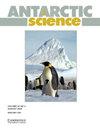Plocamium sp.海藻微卫星位点的发育。
IF 2
4区 地球科学
Q3 ENVIRONMENTAL SCIENCES
引用次数: 2
摘要
大型藻类覆盖了南极半岛西部(WAP;Wiencke & Amsler 2012)。林下群落中最常见和最广泛的成员之一是红巨藻Plocamium sp. (Heiser et al. 2020)。它支持最高的片足类和腹足类密度,并通过高度多样化的化学防御免受捕食(Heiser et al. 2020)。基于线粒体cox1条形码的单倍型多样性显示了一些地理结构以及与特定化学防御相关的证据(Shilling et al. 2021)。这些粗糙的遗传多样性模式不足以理解Plocamium sp.沿着WAP的群体结构过程,需要使用更多的多态,核位点,如微卫星。微卫星已经能够对自交(即自受精)与异交(例如Winn等人,2011)以及有性生殖与无性生殖(例如Vallejo-Marín等人,2010)的相对比率进行实证量化,但研究主要局限于被子植物或动物,对大型藻类的研究要少得多(KruegerHadfield等人,2021)。像许多大型藻类一样,Plocamium sp.具有单倍体-二倍体的生命周期,具有自由生活的二倍体四孢子体和自由生活的单倍体配子体,除非它们是生殖的,否则在形态上难以区分(图S1;Heiser et al. 2020)。减数分裂发生在四孢子植物上,导致单倍体四孢子的释放。四孢子萌发并发育成雄性和雌性配子体。配子由配子体进行有丝分裂产生,但受精后,合子保留在雌性配子体上,在那里形成车孢子体。每个二倍体碳孢子都能萌发成四孢子体。在自然种群中,许多菌体是营养性的,因此很难区分各个阶段。这一生命周期导致了独特的生态进化后果,挑战了传统的理解和常用代理来描述生殖系统变异模式的效用(Krueger-Hadfield et al. 2021)。例如,Plocamium sp.有独立的性别,但这并不妨碍自交(配子体间自交;参见Klekowski 1969)。因此,性别分离不能作为推断自然种群异交的依据。相反,我们必须使用种群遗传工具,以经验量化自然种群中自交、异交和无性繁殖的相对比率。我们开发了微型卫星来量化Plocamium sp.的遗传多样性和基因流动模式(Heiser 2022)。我们选择微卫星而不是其他方法有以下几个原因:1)微卫星有助于向数据集迭代添加新样本,这在大多数通过测序(GBS)方法识别单核苷酸多态性的基因分型中是不可能的;2)当缺乏关于倍性和生殖系统的现有数据时,微卫星是一个合适的工具,这可能会使GBS方法的下游生物信息学复杂化;3)微卫星是量化大型藻类繁殖模式变化的有力工具(Krueger-Hadfield et al. 2021)。我们于2016年至2018年夏季在安弗斯岛帕尔默站附近的'East Litchfield'和Laggard岛收集了Plocamium sp.菌体(详见补充材料)。所有配子体都有一个等位基因,所有四孢子体都有一个或两个等位基因,证实了我们的10个多态性微卫星位点是单位点遗传决定论(表S1)。单倍体配子体中未扩增的零等位基因频率的直接估计值(< 5%)与二倍体四孢子体中最大似然估计值之间存在差异(0-39%;表S2)。当种群不随机交配时,这是二倍体中零等位基因频率估计值的假设,在其他单倍体-二倍体大型藻类中发现了直接和最大似然估计值之间的差异(例如Krueger-Hadfield et al. 2013)。由于也没有短等位基因显性的证据(表S3),这10个位点有望用于未来的群体遗传分析。南极科学35(1),43-45(2023)©The Author(s), 2023。剑桥大学出版社,南极科学有限公司出版。这是一篇开放获取的文章,在知识共享署名许可(http:// creativecommons.org/licenses/by/4.0/)的条款下分发,该许可允许不受限制的重复使用、分发和复制,前提是原始文章被适当引用。doi: 10.1017 / S0954102022000475本文章由计算机程序翻译,如有差异,请以英文原文为准。
Microsatellite locus development in the seaweed Plocamium sp.
Macroalgae cover up to 80% of the benthos along the western Antarctic Peninsula (WAP; Wiencke & Amsler 2012). One of the most common and widespread members of the understory community is the red macroalga Plocamium sp. (Heiser et al. 2020). It supports among the highest amphipod and gastropod densities and is protected from predation through highly diverse chemical defences (Heiser et al. 2020). Haplotypic diversity, based on the mitochondrial cox1 barcode, showed some evidence of geographical structure as well as correlation with specific chemical defences (Shilling et al. 2021). These coarse patterns of genetic diversity are insufficient to understand the processes structuring populations of Plocamium sp. along the WAP, necessitating the use of more polymorphic, nuclear loci, such as microsatellites. Microsatellites have enabled the empirical quantification of the relative rates of selfing (i.e. self-fertilization) vs outcrossing (e.g. Winn et al. 2011) and sexual vs asexual reproduction (e.g. Vallejo-Marín et al. 2010), but studies have been restricted largely to angiosperms or animals, with far fewer investigations in macroalgae (KruegerHadfield et al. 2021). Plocamium sp., like many macroalgae, has a haploid-diploid life cycle, with free-living diploid tetrasporophytes and free-living haploid gametophytes, which are morphologically indistinguishable unless they are reproductive (Fig. S1; Heiser et al. 2020). Meiosis occurs on the tetrasporophytes, resulting in the release of haploid tetraspores. Tetraspores germinate and develop into male and female gametophytes. Gametes are mitotically produced by the gametophytes, but, following fertilization, the zygote is retained on the female gametophyte, where the carposporophyte develops. Each diploid carpospore can germinate into a tetrasporophyte. In natural populations, many thalli are vegetative, rendering it difficult to distinguish the stages. This life cycle results in unique eco-evolutionary consequences that challenge traditional understanding and the utility of common proxies to describe patterns of reproductive system variation (Krueger-Hadfield et al. 2021). For example, Plocamium sp. has separate sexes, but this does not preclude selfing (intergametophytic selfing; see Klekowski 1969). Separate sexes, therefore, cannot be used as a proxy to deduce outcrossing in natural populations. Instead, we must use population genetic tools to empirically quantify the relative rates of selfing, outcrossing and asexual reproduction in natural populations. We developed microsatellites to quantify patterns of genetic diversity and gene flow in Plocamium sp. (Heiser 2022). We chose microsatellites over other approaches for several reasons: 1) microsatellites facilitate the iterative addition of new samples to a dataset, something that is not possible in most genotyping by sequencing (GBS) approaches to identify single nucleotide polymorphisms; 2) microsatellites are an appropriate tool when existing data on ploidy and the reproductive system are absent, which may complicate downstream bioinformatics in GBS approaches; and 3) microsatellites are a powerful tool with which to quantify reproductive mode variation in macroalgae (Krueger-Hadfield et al. 2021). We collected Plocamium sp. thalli during summers between 2016 and 2018 at 'East Litchfield' and Laggard Island near Palmer Station on Anvers Island (see Supplemental Materials for details). All gametophytes had one allele and all tetrasporophytes had one or two alleles, confirming that our 10 polymorphic microsatellite loci are in single-locus genetic determinism (Table S1). There were discrepancies between the direct estimates of null allele frequencies from non-amplification in the haploid gametophytes (< 5%) and those estimated using maximum likelihood in the diploid tetrasporophytes (0–39%; Table S2). When populations are not mating at random, which is an assumption of null allele frequency estimators in diploids, discrepancies between direct and maximum likelihood estimates have been found in other haploid-diploid macroalgae (e.g. Krueger-Hadfield et al. 2013). As there was also no evidence for short allele dominance (Table S3), these 10 loci are promising for future population genetic analyses. Antarctic Science 35(1), 43–45 (2023) © The Author(s), 2023. Published by Cambridge University Press on behalf of Antarctic Science Ltd. This is an Open Access article, distributed under the terms of the Creative Commons Attribution licence (http:// creativecommons.org/licenses/by/4.0/), which permits unrestricted re-use, distribution and reproduction, provided the original article is properly cited. doi:10.1017/S0954102022000475
求助全文
通过发布文献求助,成功后即可免费获取论文全文。
去求助
来源期刊

Antarctic Science
地学-地球科学综合
CiteScore
3.60
自引率
6.20%
发文量
42
审稿时长
3 months
期刊介绍:
Antarctic Science provides a truly international forum for the broad spread of studies that increasingly characterise scientific research in the Antarctic. Whilst emphasising interdisciplinary work, the journal publishes papers from environmental management to biodiversity, from volcanoes to icebergs, and from oceanography to the upper atmosphere. No other journal covers such a wide range of Antarctic scientific studies. The journal attracts papers from all countries currently undertaking Antarctic research. It publishes both review and data papers with no limits on length, two-page short notes on technical developments and recent discoveries, and book reviews. These, together with an editorial discussing broader aspects of science, provide a rich and varied mixture of items to interest researchers in all areas of science. There are no page charges, or charges for colour, to authors publishing in the Journal. One issue each year is normally devoted to a specific theme or papers from a major meeting.
 求助内容:
求助内容: 应助结果提醒方式:
应助结果提醒方式:


